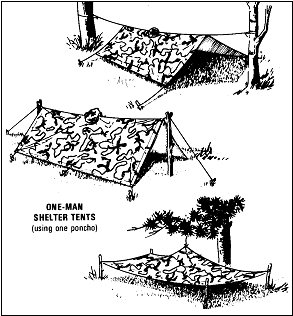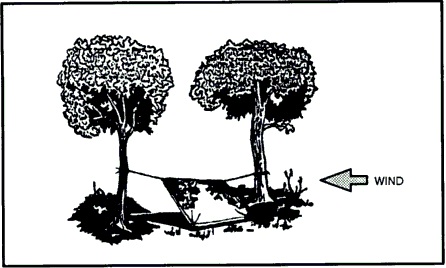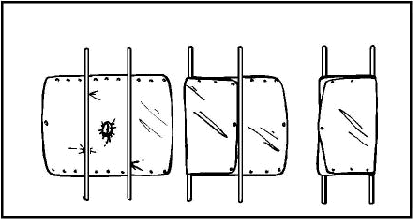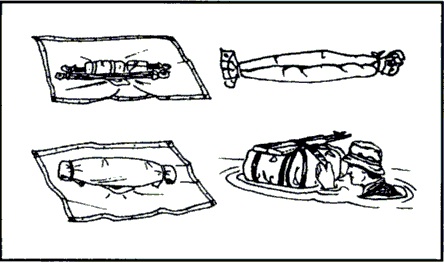If you do not have a military poncho in your survival kit or bugout bag, it needs to be your next purchase. Combined with some para cord or bungee cables the military poncho is one of the most versatile objects in your bag and can greatly increase your comfort and survival chances while in the field. Small, lightweight, tear resistant and waterproof the poncho has been around for many years and has been seen many wars on the shoulders of our military members. The three most popular uses for the poncho that I have seen are: wearing as a rain coat, waterproof ground cloth, sleeping bag (when combined with poncho liner). In addition to those the poncho has many other uses/configurations for the field or survival, I will highlight a few of those here.
Poncho Hooch: Using para cord or bungee cables, the poncho can be tied between a few trees to create a makeshift shelter. It is important to note that the hood should be cinched up, and elevated above the rest of the hooch so as to create a slope for the water to flow off of. You can tie para cord to the hood and tie it up to a tree limb in order to accomplish this. From my experience the hooch should be very low to the ground so that crosswinds or sideways rain cannot gain access through the side openings. An example of the hooch is below (3rd example) in addition to a few other shelter configurations.

Poncho Lean To: While a hooch can provide a nice form a shelter a lean to is a much quicker configuration to set up and can be great during the heat of the day. You can string up the poncho between two trees or even off the side of a vehicle. When the humidity is above 90% and the temps are near 100 degrees the poncho lean to can provide much needed protection from the sun.

Poncho Litter: The poncho is very strong, and when folded and snapped between 2 sturdy branches (or poles) it can be a great field expedient litter for carrying an injured person. When folded over itself the weight of the person on the litter helps to keep the poncho from coming apart.
 Poncho Raft: As previously mentioned the poncho is virtually waterproof, and as such it can be bundled around a rucksack or even collected debris (brush) to create a raft which will assist in crossing a body of water. This is best done (and most effective) with two ponchos, as seen in the example below.
Poncho Raft: As previously mentioned the poncho is virtually waterproof, and as such it can be bundled around a rucksack or even collected debris (brush) to create a raft which will assist in crossing a body of water. This is best done (and most effective) with two ponchos, as seen in the example below.

The poncho is a very versatile piece of equipment and should absolutely be part of every prepper’s bugout bag/kit. It can serve as protection from the elements when worn or used as a shelter and can be configured in many other practical ways. The lightweight and rugged nature of the poncho means that it will be very resistant to tough use, but if it does get destroyed it is not overly expensive to replace. Check out this video which expands on the information I have already provided, 9 different poncho survival shelter setups.









7 comments
Skip to comment form
As a former Infantryman.. I would recommend having at least 2 ponchos per person. You will need to lay one on the ground or need another one as there are many uses for one. Get a poncho liner too!
The famous woobie! No infantryman would think of going to the field without it. Ponchos are legit too. Somehow mine got ripped up. Luckily I have access to these wonderful gems.
I was also thinking of water collection. Invert the tent designs and place a bowl or other bottle under the hood where it will gather and drip down. You could even sit under it and stay dry while a source of fresh water drips down for you to drink.
Author
JA
Great idea and definitely one I left off the list. Thanks for adding it!
Great article…I think it’s the first time I’ve seen anyone recommend elevating the hood on the hooch…but you get wet if you don’t, I always use a bungie for that as well as the corners.
Author
Most definitely, have to tie up and elevate the hood for proper hooch construction!
They always use rugs in the movies but I prefer a poncho for discretely moving a body out of an appointment. It also doubles as a drop cloth for dismemberment, if that’s your thing.